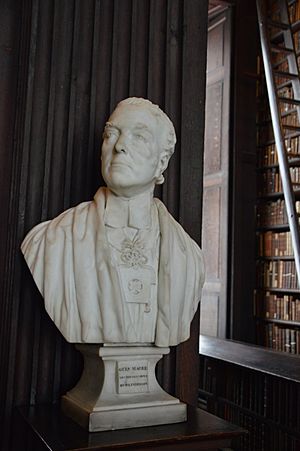William Magee (archbishop of Dublin) facts for kids
Quick facts for kids The Most Reverend William Magee D.D. |
|
|---|---|
| Archbishop of Dublin Primate of Ireland |
|

Bust of William Magee in the Trinity College library
|
|
| Church | Church of Ireland |
| Diocese | Dublin and Glendalough |
| Appointed | 24 June 1822 |
| In Office | 1822–1831 |
| Predecessor | Lord John Beresford |
| Successor | Richard Whately |
| Orders | |
| Consecration | 24 October 1819 |
| Personal details | |
| Born | 18 March 1766 Enniskillen, County Fermanagh, Kingdom of Ireland |
| Died | 18 August 1831 (aged 65) Stillorgan, County Dublin, Ireland |
| Buried | St Patrick's Cathedral, Dublin |
| Nationality | Irish |
| Denomination | Anglican |
| Parents | John Magee & Jane Glasgow |
| Previous post | Bishop of Raphoe (1819–1822) |
William Magee (born March 18, 1766 – died August 18, 1831) was an important Irish teacher and a leader in the Church of Ireland. He taught mathematics at Trinity College Dublin for many years. Later, he became a Bishop in Raphoe and then the Archbishop of Dublin.
Contents
William Magee's Early Life
William Magee was born in Enniskillen, County Fermanagh, Ireland. He was the third son of John Magee, a farmer, and Jane Glasgow.
Education at Trinity College
He went to Trinity College Dublin for his education. He earned several degrees there, including a Bachelor of Arts (BA) in 1786 and a Doctor of Divinity (DD) in 1801. He was recognized as a bright student and became a Scholar in 1784. In 1788, he was chosen as a Fellow, which is a special academic position.
A Professor of Mathematics
In 1800, William Magee became the Erasmus Smith Professor of Mathematics at Trinity College. He was also a Senior Fellow. Even though he wasn't mainly a research mathematician, he was a very popular teacher. Students liked him a lot. In 1813, he was elected a Fellow of the Royal Society. This honor recognized his strong knowledge in mathematics and philosophy.
A Career in the Church
William Magee was ordained, meaning he became a priest, in the Church of Ireland in 1790. He was known for his powerful sermons.
Important Writings
Two of his sermons, given in the college chapel, became the basis for his important book. This book was called "Discourses on the Scriptural Doctrines of Atonement and Sacrifice" (1801). It was a strong argument against some ideas of Unitarianism, which is a different type of Christian belief.
Becoming a Bishop and Archbishop
In 1812, he left his teaching job at Trinity College. He took on leadership roles in churches in Cappagh, County Tyrone, and Killyleagh, County Down. In 1813, he became the Dean of Cork.
William Magee was well-known as a preacher. He also supported the Second Reformation in Ireland, which aimed to spread Protestantism. In 1819, he was made the Bishop of Raphoe. Then, in 1822, he became the Archbishop of Dublin. He held this important position until he passed away.
Views on Politics
While he was generally a tolerant person, he did not support the movement for Catholic Emancipation. This movement aimed to give more rights to Catholics in Ireland.
Later Life and Family
William Magee passed away on August 18, 1831, in Stillorgan, near Dublin. He had a large family with 16 children. Three of his sons and nine of his daughters were still alive when he died. His grandson, William Connor Magee, also became an Archbishop, serving in York.

